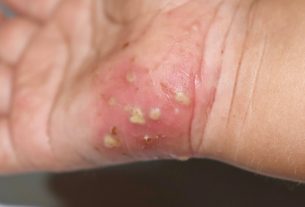By Alice B. Gottlieb, MD, PhD, dermatologist, as told to Kristen Fischer
Certain things, like your genes, can increase your risk for psoriatic arthritis. If you have a first-degree relative with psoriatic arthritis, you have 39 times the risk of developing it.
Other risks for psoriatic arthritis include psoriasis on the scalp and nails. Inverse psoriasis, or intertriginous psoriasis, also raises your risk for psoriatic arthritis. (Inverse psoriasis occurs in folds of the body, such as in the armpits or groin area.)
A common misconception is that only people with moderate to severe psoriasis get psoriatic arthritis. You can get psoriatic arthritis even if you have mild psoriasis. Early detection is key. If you can manage psoriasis, you may be able to stop psoriatic arthritis from getting worse – maybe prevent it completely.
Why Does Early Diagnosis of Psoriatic Disease Matter?
Family doctors – especially dermatologists – need to spot psoriasis so they can prevent disabilities caused by psoriatic arthritis. Once detected, we can do something about it.
That’s a paradigm shift from when I was a rheumatology fellow at the Hospital for Special Surgery. Back then, we had nothing that could keep the disease from getting worse. Doctors didn’t even control signs and symptoms that well.
Now there are several medications on the market to treat psoriatic arthritis . Some are tumor necrosis factor (TNF)-alpha inhibitors blockers, Interleukin inhibitors, and JAK inhibitors.
There’s also research that found people who took medication had less damage, compared to those who didn’t. That suggests that you may even prevent psoriatic arthritis.
How Can Dermatologists Detect Psoriatic Disease?
Dermatologists may not know how important their role is in detecting psoriatic arthritis. They don’t have to be experts in diagnosing it, but they must check for it. Then they can refer you to a rheumatologist. They need to ask you about joint pain. Many people don’t realize that aches and pains can be a disease. It has to be brought up.
Missing a diagnosis can be serious. Research tells us that a delay in diagnosis and treatments causes increased joint erosion, deformity, and arthritis mutilans (a form of psoriatic arthritis where bone degeneration shortens your fingers and toes).
In dermatology practices, people usually have signs of enthesitis before they have a psoriatic disease. Enthesitis is inflammation where tendons and ligaments insert into bone. It can cause joint pain, stiffness, and mobility problems. Some ultrasound evidence shows that enthesitis increases the risk of a future psoriatic arthritis diagnosis by five times.
How Is Psoriatic Disease Care Improving?
Doctors have simple, quick screening methods to spot psoriatic diseases. We need to get these in the hands of more general practice doctors and dermatologists – and they have to use them.
I’m working with a team to encourage more doctors to use these screening tools. Mount Sinai recently started a new program that integrates psoriatic disease screening tools with our electronic medical records (EMRs).
Here’s how it works: People who come to us will respond to the five-question Psoriasis Epidemiology Screening Tool (PEST) while they’re in the waiting room. When they see their doctor, their PEST results will come up on the EMR. If they answer three or more questions positively, the EMR application alerts the doctor that the score shows possible psoriatic arthritis. It will give the doctor a prompt to refer the patient to a rheumatologist. It couldn’t be easier.
They’re also integrating the industry-standard Psoriatic Arthritis Impact of Disease (PsAID) Questionnaire into EMR. People with an existing psoriatic disease, or those who are PEST-positive, will have to respond to 12 questions. If they have a certain score, it will alert the doctor that the case is not controlled. It will then prompt the doctor to set up an appointment with a rheumatologist. The EMR will also suggest medications.
These screening tools are available in some other EMR systems, but my project is different because I will measure how well it works.
At the end of 18 months, I’ll see if the percentage of cases goes up. The system will be able to tell if people are managing their psoriatic diseases, and we will be able to assess how treatments work.
If all goes well, this will make it easy for doctors to give patients better care. It will help them to be more aware about diagnosing psoriatic diseases, and to know if people have their disease under control.
The screening tools are available on the GRAPPA app, which is produced by the Group for Research and Assessment of Psoriasis and Psoriatic Arthritis.
What’s New in Psoriatic Disease Medications?
There are some advances in medications to treat psoriatic arthritis. TNF blockers are the gold standard to treat psoriatic diseases. But they don’t work for everyone.
Deucravacitinib is a newer FDA-approved drug for psoriasis – but not for psoriatic arthritis. There is some evidence that it can improve psoriatic arthritis. Clinical trials look good for bimekizumab, an oral medication that clears skin for 3 years, but it is not yet approved in the U.S.
In 2023, adalimumab (Humira) will be available in generic form. I don’t think the price will come down much.
I give preference to treatments that stop psoriatic arthritis from getting worse, even in patients that only have psoriasis. That’s because there’s some evidence that the drugs may prevent psoriatic arthritis.
For now, the combination of working treatments – and getting more people diagnosed so we can prevent disabilities from psoriatic diseases – is a priority.
We have great treatments for psoriatic diseases, but many are expensive. Many people can’t afford them, even people with supplemental insurance.
What’s Next for Psoriatic Arthritis and Psoriasis?
Overall, people need to know that psoriasis is much more than something that affects their skin. It can cause lasting damage and complications.
That’s why screening for psoriasis and psoriatic arthritis is so important, and why I’m dedicated to making sure everyone gets checked.



